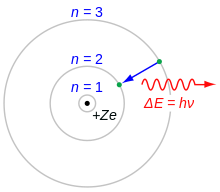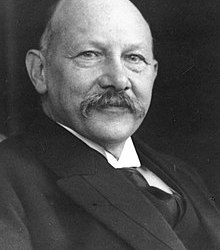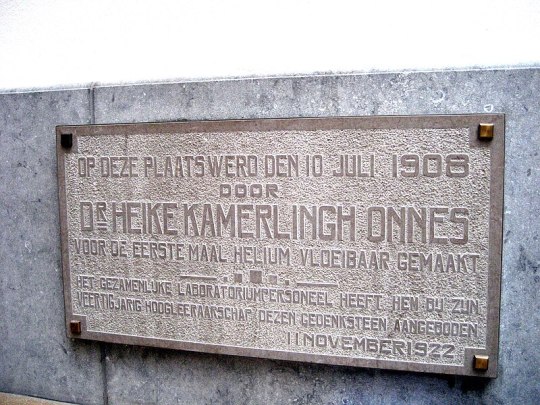#ScientistSaturday
Text


Niels Henrik David Bohr (7 October 1885 – 18 November 1962)
A Danish physicist, Niels Henrik David Bohr is perhaps most well known for his work on the structure of the atom and the resulting Bohr model. Bohr built off of Ernest Rutherford's previous atomic model, proposing that electrons orbited the nucleus at discrete energy levels and were able to jump between levels with the addition or expulsion of energy. Although more accurate models exist today, the Bohr model remains a useful tool for understanding atomic structure. Bohr was eventually awarded the 1922 Nobel prize in physics for his work. He also predicted the existence of hafnium (named for Copenhagen) and worked extensively in the field of quantum mechanics.
Though he spent most of his life in Denmark, Bohr and his family were forced to flee the country when the Nazis took over during World War II as his mother was Jewish. As a result, he spent the final years of the war in Britain and the United States, working on the Manhattan project and was an early proponent of international cooperation regarding nuclear weapons and nuclear power.
Element 107, bohrium, is named in his honor.
Sources/Further Reading: (Images source - Wikipedia) (Biography.com) (LiveScience) (Nobel Prize) (PBS)
51 notes
·
View notes
Photo

For our last #ScientistSaturdays @goCMNH, I used my favorite @celestronuniverse microscope, the MicroDirect 1080p HD to show Dr. Sarah Diamond's TINY acorn ants! Kids (of all ages) loved peering into their secret lives.
1 note
·
View note
Text

Wallace Hume Carothers (27 April 1896 – 29 April 1937)
An American chemist and inventor, Wallace Hume Carothers grew up in the state of Iowa before gaining his first degree in chemistry in Missouri, including working as an instructor even before his graduation. He worked for a number of universities during and after obtaining further degrees before moving to work for DuPont in 1927. Carothers spent his time at DuPont working on polymer science and is perhaps most well known for being largely credited with the discovery of nylon. He holds the patent for this polymer alongside Julian Hill and other researchers for this laboratory. In addition, Carothers was also instrumental in the development/invention of neoprene.
Sources/Further Reading: (Image source - Wikipedia) (Science History Institute) (ACS) (2008 news article) (MIT)
19 notes
·
View notes
Text

Clinton Joseph Davisson (22 October 1881 – 1 February 1958) and Lester Halbert Germer (10 October 1896 – 3 October 1971)
Both American physicists, Lester Halbert Germer was a junior assistant under Clinton Joseph Davisson when the two of them performed an experiment that led to discovering electron diffraction. Davisson would be awarded the Nobel Prize in physics in 1937 for this discovery, shared with George Paget Thomson, who discovered the same thing independently. Germer, as an assistant, did not share in the Nobel Prize, but his name remains attached to the experiment itself. The Davisson–Germer experiment was conducted on a nickel surface; bombarding it with electrons with known momentum at an angle, a diffraction pattern emerged. It was the first demonstration of the wavelike nature of the electron predicted by de Broglie.
Sources/Further Reading: (Image source - Davisson Wikipedia) (Oxford Reference, Davisson) (IUCr, Davisson) (Davisson Biographical Memoir) (Germer Wikipedia) (Linda Hall Library, Germer)
#Materials Science#Science#Electrons#Diffraction#Scientists#Science history#ScientistSaturday#2024Daily
16 notes
·
View notes
Text

André Guinier (1 August 1911 – 3 July 2000)
A French scientist, André Guinier lived, was educated, and worked in the country of his birth. His initial degrees were in the field of physics, followed by a doctorate thesis on X-ray crystallography. His work on this latter topic is perhaps one of the things he is most well known for, including the development of small-angle X-ray scattering. In the field of metallurgy, however, he is also well known for his work on age- and precipitation-hardening of alloys, specifically aluminum-copper alloys. He shares credit with G.D. Preston (who independently researched the same phenomena) for these observations and the Guinier–Preston zone is named in honor of both of them.
Sources/Further Reading: (Image source - 2019 article) (IUCr) (SFMC) (1955 article) (Wikipedia)
#Materials Science#Science#Scientists#Science history#Materials characterization#Metallurgy#ScientistSaturday#2024Daily
19 notes
·
View notes
Text

Hermann Staudinger (23 March 1881 – 8 September 1965)
A German chemist, Hermann Staudinger is known as the man who first understood the molecular structure of high molecular weight polymers, giving birth to the field of polymer chemistry. His published work in 1920 was the first to state that natural polymers such as rubber, starch, and proteins are long chains of short repeating molecular units linked by covalent bonds, focusing particularly on high molecular weight polymers or macromolecules. For this work, he was awarded the Nobel Prize in chemistry in 1953.
Sources/Further Reading: (Image source - ACS) (Science History) (2020 article) (Wikipedia)
17 notes
·
View notes
Text


Leo Hendrik Baekeland (14 November 1863 – 23 February 1944)
Born in Belgium, and educated in both Belgium and Germany, Leo Baekeland moved to the United States in 1889 and spent most of the rest of his life in that country. Educated as a chemist, Baekeland began his career working with photographic paper followed by some time spent working as in the field of electrochemistry and the electrolysis of sodium chloride before beginning his work with resins. He is most remembered for this latter work and the invention of Bakelite the first fully synthetic plastic which began the age of plastics. His patent for the process was filed in 1907 and the Bakelite company was founded in 1910. Though Bakelite has since been replaced by many other plastics at the time of Baekeland's death it was used in thousands of different products.
Sources/Further Reading: (Images source - Wikipedia) (Science History Institute) (ACS) (Discovering Belgium) (PBS)
21 notes
·
View notes
Text

Walter Moritz Boas (10 February 1904 – 12 May 1982) and Erich Schmid (4 May 1896 – 22 October 1983)
A German-Austrian metallurgist and Austrian physicist respectively, Walter Moritz Boas and Erich Schmid are most well known for a book they coauthored together: "Kristallplastizität: Mit Besonderer Berücksichtigung der Metalle", or "Plasticity of Crystals: with special reference to metals". Together they are regarded as pioneers in the field of crystal plasticity and the book itself was already well regarded only a short time after it's publication.
The Schmid factor, introduced in the book, was named in honor of Schmid.
Sources/Further Reading: (Image source, Boas Wikipedia) (Australian Academy of Science, Boas) (CSIRO, Boas) (Austrian Academy of Sciences, Schmid) (Schmid Wikipedia)
#Materials Science#Science#Scientists#Plasticity#Science history#Metallurgy#ScientistSaturday#2024Daily
10 notes
·
View notes
Text

Sir George Paget Thomson (3 May 1892 – 10 September 1975)
A British physicist, Sir George Paget Thomson was awarded the 1937 Nobel Prize in physics (alongside Clinton Davisson, who made the discovery independently) for his work in electron diffraction. Thomson grew up as the son of a physicist - J. J. Thomson, also a Nobel Prize winner credited for the discovery of electrons. Whereas his father's work showed the electron as a particle, Thomson (and Davisson) was able to demonstrated the wavelike nature of the electron.
Sources/Further Reading: (Image source - Wikipedia) (Nobel Prize) (Oxford Reference) (The Franklin Institute)
#Materials Science#Science#Scientists#Electrons#Diffraction#ScientistSaturday#Science history#2024Daily
13 notes
·
View notes
Text

Michael Polanyi (11 March 1891 – 22 February 1976)
Born Mihály Pollacsek in Budapest in 1891, Michael Polanyi first studied medicine at the University of Budapest before studying chemistry in Germany. He served in the Austro-Hungarian army as a medical officer during World War I, finishing a PhD on adsorption in the meantime, then returned to medicine after the war. He emigrated to Germany briefly, then again to the UK in 1933 after the rise of the Nazi party, working in the field of physical chemistry. Polanyi is often regarded as a polymath, with diversified interests throughout his life including chemistry, economics, and philosophy. In the field of materials science he is known for his work, simultaneous but independent from the work of Egon Orowan and G.I. Taylor, proposing a theory of plastic deformation in ductile materials using the theory of dislocations.
Sources/Further Reading: (Image source - Wikipedia) (infed.org) (ISI) (1996 article)
#Materials Science#Science#Plasticity#Dislocations#Scientists#Science history#ScientistSaturday#2024Daily
11 notes
·
View notes
Text

Julian W. Hill (1904 - 29 January 1996)
Though less famous than his one-time boss, Wallace Carothers, Julian Hill was an American chemist who was instrumental in the development and discovery of the polymer nylon. Born in the state of Missouri and educated at the University of Washington in St. Louis, followed by MIT, Hill is typically specifically credited with the discovery that the polymer could be stretched and pulled when heated as well as its appearance and texture when cooled to room temperature.
Sources/Further Reading: (Wikipedia) (1996 news article) (ACS)
Image source.
15 notes
·
View notes
Text

Sir Geoffrey Ingram Taylor (7 March 1886 – 27 June 1975)
A British physicist and mathematician, Sir Geoffrey Ingram Taylor studied at Cambridge, publishing his first paper while still an undergraduate. His initial work was on light and photons before he began his research in the field of fluid mechanics with an emphasis on turbulence. Later he branched out to include studies in solid mechanics and he became known for work on the plastic deformation of ductile materials, proposing an explanation based on the theory of dislocations in 1934 (independent from work proposed by Egon Orowan and Michael Polanyi). Many phenomena and scientific principles were named in his honor, including Rayleigh-Taylor instabilities and the Taylor number.
Sources/Further Reading: (Image source - Wikipedia) (MacTutor) (Resolved Analytics) (1996 article)
#Materials Science#Science#Fluid dynamics#Plasticity#Dislocations#Scientists#Science history#ScientistSaturday#2024Daily
11 notes
·
View notes
Text

Waldo Lonsbury Semon (10 September 1898 – 26 May 1999)
An American scientist, Waldo Lonsbury Semon was one of the first individuals in the country to be awarded a doctorate in chemical engineering. His most famous accomplishment was his invention of plasticized polyvinyl chloride (PVC), broadening the scope of applications of the material immensely (PVC is now the third most common polymer). In addition, he is also credited for commercializing said plasticizers, again increasing their use and popularity. Semon worked for almost 40 years for the B. F. Goodrich Company, spending most of his time on polymers and rubbers, including the development of synthetic rubbers. After retirement, he continued to work as a research professor at Kent State University.
Sources/Further Reading: (Image source - Wikipedia) (Plastics Hall of Fame) (MIT) (ThoughtCo)
#Materials Science#Science#Polymers#Plastics#Polyvinyl chloride#Scientists#Science history#ScientistSaturday#2024Daily
12 notes
·
View notes
Text

Ernst August Friedrich Ruska (25 December 1906 – 27 May 1988) and Max Knoll (17 July 1897 – 6 November 1969)
A German physicist and German engineer, respectively, Ernst August Friedrich Ruska and Max Knoll were co-inventors of the electron microscope in 1931. A transmission electron microscope (the scanning version would not be created until later), the invention allowed researchers access to new length scales and significantly improved understanding of materials' structures. The exact inventor of the microscope is considered slightly controversial however. Reinhold Rüdenberg, in the United States, filed a patent in 1932, though the date at which he had a working instrument is unknown. Regardless, Ruska was not awarded a Nobel Prize for his work until 1986, at which point both Knoll and Rüdenberg were deceased and ineligible for the prize.
Sources/Further Reading: (Image source - Frank Lab) (Nobel Prize) (SciHi Blog) (Ruska Wikipedia) (Knoll Wikipedia) (Electron Microscope Wikipedia)
#Materials Science#Science#Electron microscopy#Scientists#Science history#ScientistSaturday#2024Daily
10 notes
·
View notes
Text


Heike Kamerlingh Onnes (21 September 1853 – 21 February 1926)
A Dutch physicist, Heike Kamerlingh Onnes spent much of his career working in cyrogenics and low temperature applications. In 1908 he managed to produce liquid helium, the first to do so and an achievement for which he would later win a Nobel Prize in physics in 1913. His work is sometimes credited as the beginnings of the field of cryogenics in fact and his achievement of liquid helium would lead him three years later to discover superconductivity as well, with many of those initial experiments conducted on mercury.
Sources/Further Reading: (Images source - Wikipedia) (2010 article) (2013 article) (The Nobel Prize)
15 notes
·
View notes
Text

Friedrich Wöhler (31 July 1800 – 23 September 1882)
Perhaps most well known for his work in organic chemistry, as the first to synthesis urea (an organic substance) from inorganic materials, Friedrich Wöhler was a German chemist who got his doctorate in "Medicine, Surgery, and Obstetrics". In addition to his work in organic chemistry, however, Wöhler also made significant contributions to the field of inorganic chemistry, most notably in the isolation of various elements. He is regarded as the second to isolate aluminum (and the first to get significant quantities of the pure metal), as well as beryllium and yttrium, made significant progress in the isolation of titanium, and was the first to isolate crystalline forms of silicon and boron. Wöhler was also known as a good teacher and lecturer and one of the first to involve students in research.
Sources/Further Reading: (Image source - Wikipedia) (Science History) (Michigan State University)
#Materials Science#Science#Scientists#Science History#Organic chemistry#Chemistry#Elements#ScientistSaturday#2024Daily
21 notes
·
View notes